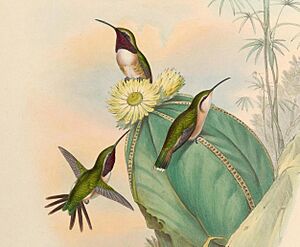Beautiful sheartail facts for kids
The beautiful sheartail or beautiful hummingbird (Calothorax pulcher) is a tiny, colorful hummingbird found only in Mexico. It's part of a group of hummingbirds known as "bee hummingbirds" because they are so small.
Quick facts for kids Beautiful sheartail |
|
|---|---|
 |
|
| Conservation status | |
| Scientific classification | |
 |
Contents
About the Beautiful Sheartail
What's in a Name?
The beautiful sheartail belongs to a group of hummingbirds called Calothorax. Its closest relative is the Lucifer sheartail. The beautiful sheartail is "monotypic," which means it's the only type of beautiful sheartail, with no different subspecies.
How to Spot One
The beautiful sheartail is a small bird, about 7.7 to 9 cm (3.0 to 3.5 in) long. That's about the length of your finger! It weighs only about 2.2 to 3 g (0.078 to 0.11 oz), which is less than a penny.
Both male and female beautiful sheartails have a long, slightly curved black beak.
- Males are super colorful! Their backs are a shiny bronze-green. They have a white stripe behind each eye. Their throat, called a gorget, is a bright, shiny magenta-purple. This color can look more violet or blue from different angles. The feathers at the back of their gorget are longer. Their chest is grayish-white, and their sides are bronze-green. The feathers under their tail are white. Their tail is long and forked, like a "V" shape. The middle tail feathers are bronze-green, and the outer ones are dark, bronzy-black.
- Females also have bronze-green backs, but their heads are a bit duller. Their undersides are a pale, grayish-tan, with cinnamon-tan on their sides. Their tail is shorter and more rounded than the male's. The middle tail feathers are bright bronze-green. The outer tail feathers are cinnamon-red at the base, black in the middle, and have white tips.
Where Do They Live?
You can only find the beautiful sheartail in south-central Mexico. They live in places like central Guerrero, southern Puebla, and Oaxaca.
They like dry and semi-dry areas with shrubs and small trees. They also live in places with trees and bushes along rivers, called "gallery forests." These birds usually live at elevations between 1,000 and 2,200 m (3,300 and 7,200 ft) high.
Beautiful Sheartail Behavior
Do They Move Around?
Most beautiful sheartails stay in the same area all year long. They are considered "resident" birds. However, a few might move to lower areas near the sea in Oaxaca after they have finished breeding.
What Do They Eat?
Beautiful sheartails mostly look for food close to the ground. But they will also feed on flowers at any height. They drink nectar from many different kinds of plants. Their close relative, the Lucifer hummingbird, is known to protect patches of flowers from other birds. Besides nectar, beautiful sheartails also catch small insects. They do this by waiting on a perch and then flying out to catch insects in the air. This is called "hawking."
How Do They Breed?
Male beautiful sheartails perform a special dance to attract females. They rock back and forth in front of the female. Then, they fly in a diving and swooping pattern.
Their breeding season seems to be from May to November. One nest found was shaped like a cup. It was made from soft plant fibers and had fluffy plant seeds (pappi) on the outside. The nest was held onto a branch with spiderwebs. A typical clutch has two eggs. We don't know much more about their breeding habits.
What Sounds Do They Make?
When a male beautiful sheartail is doing his courtship flight, he repeats a very high, thin, and slightly squeaky sound. It sounds like "t-swiik t-swiik" or "w-siiu w-siiu." Their regular call is described as high, twittering chips.
Beautiful Sheartail Status
The IUCN (International Union for Conservation of Nature) has looked at the beautiful sheartail. They have assessed it as "Least Concern." This means that, for now, it's not in immediate danger of disappearing.
The bird lives in a fairly large area. Scientists estimate there are between 20,000 and 50,000 adult beautiful sheartails. However, the number of these birds is thought to be going down. Even though the population is decreasing, no specific threats have been found that are causing this decline.


